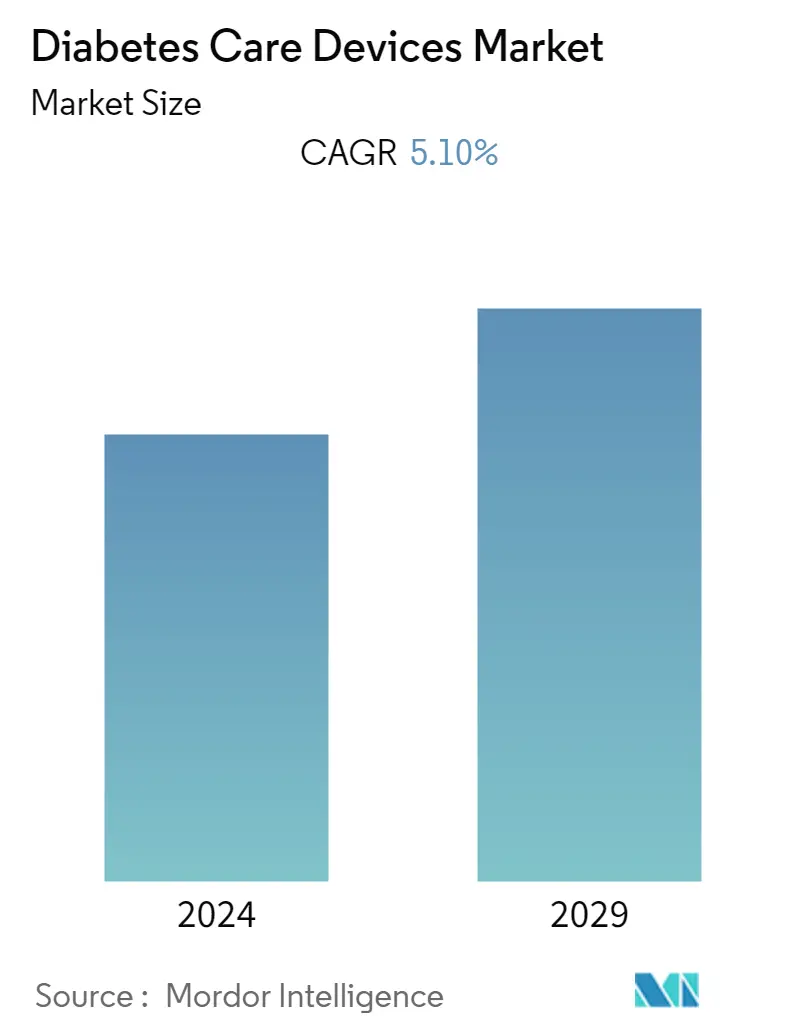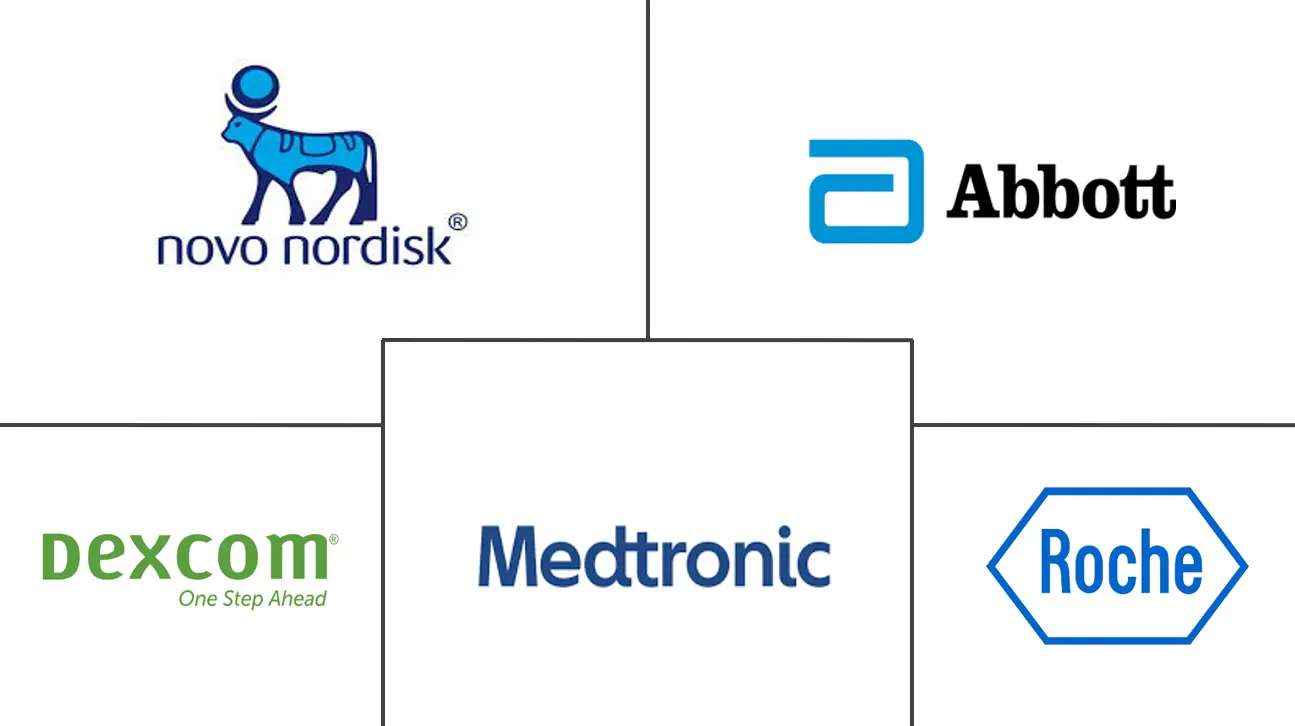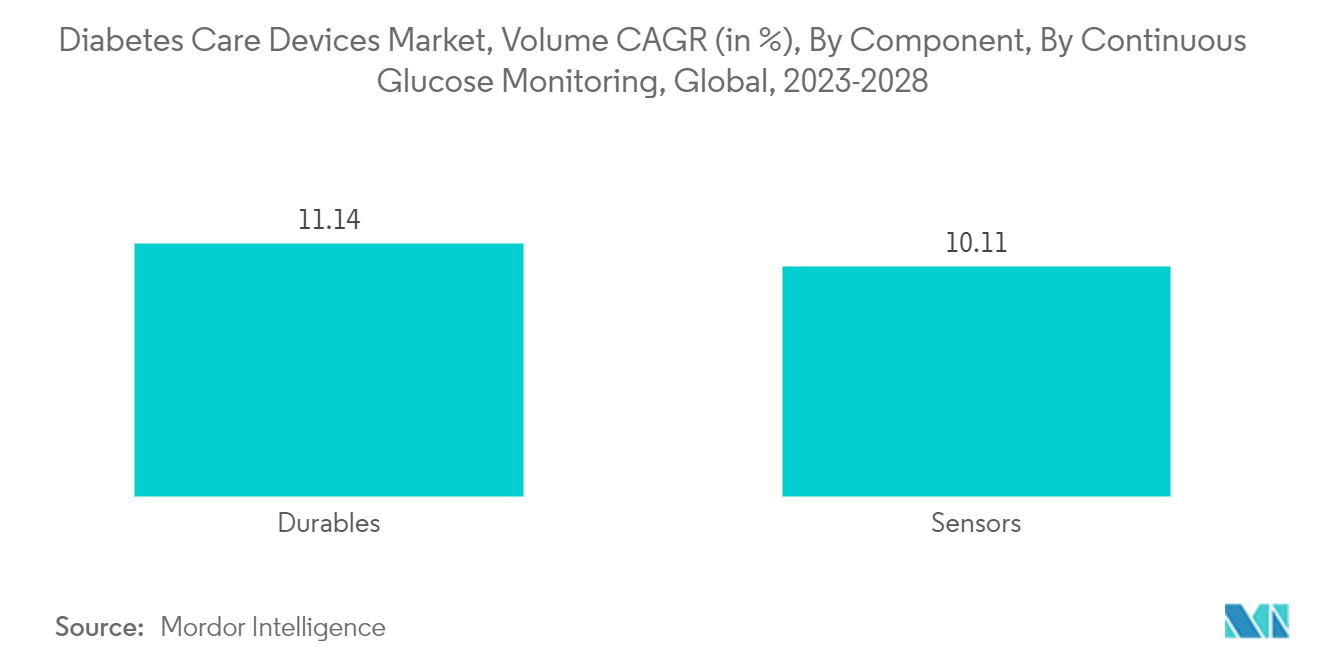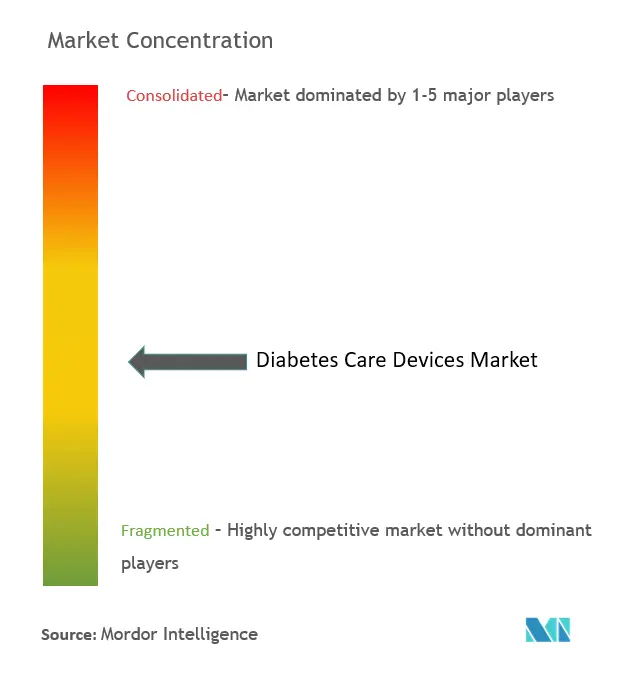Diabetes Care Devices Market Size

| Study Period | 2019 - 2029 |
| Base Year For Estimation | 2023 |
| Forecast Data Period | 2024 - 2029 |
| CAGR | 5.10 % |
| Fastest Growing Market | North America |
| Largest Market | North America |
Major Players
*Disclaimer: Major Players sorted in no particular order |
Diabetes Care Devices Market Analysis
The Global Diabetes Care Devices Market size is estimated at USD 59,522.29 million in 2023 and is expected to reach USD 76,329.64 million by 2028, registering a CAGR of 5.10% during the forecast period (2023-2028).
The COVID-19 pandemic had a substantial impact on the diabetes care devices market. The pandemic highlighted opportunities for continuing and expanding innovations in the delivery of diabetes care through virtual consultations between healthcare providers and people with diabetes and the use of diabetes technology. Crisis management created unprecedented interest in remote care from patients and providers and removed many long-standing regulatory barriers. For instance, the US Food and Drug Administration allowed personal blood glucose meters and continuous glucose monitoring devices in hospitals during the pandemic. The prevalence of diabetes in people hospitalized with COVID-19 infection and the recognition that improved glycemic control might improve outcomes and reduce the length of stay in patients with SARS-CoV-2 underlined the importance of diabetes care devices.
According to the IDF 2021 report, the global adult diabetes population was approximately 537 million, which will increase by 643 million in 2030. Continued elevation in blood glucose levels in diabetes patients can contribute to progressive complications such as renal, nerve, and ocular damage. Appropriate and timely blood glucose monitoring allows the successful management of out-of-range blood glucose levels and minimizes diabetic-related health complications. Obesity is considered one of the major factors contributing to the disease, primarily Type 2 diabetes. In obese individuals, the fat cells in the body release pro-inflammatory chemicals, which may make the body less sensitive to the insulin it produces by disrupting the function of insulin-responsive cells. Thus, these individuals need external insulin shots and must use a glucose monitoring device like a glucometer.
Innovative technologies, such as digital health apps that display and summarize individual blood glucose measurements and incorporate additional relevant data such as insulin doses, meals, and physical activity, can further support self-management while decreasing disease burden and benefitting overall diabetes care. Integration of blood glucose monitoring with insulin calculators, automated insulin titration software, and remote coaching are further developments that provide patients with poorly controlled diabetes additional support needed to improve critical outcomes, thereby enhancing the market prospects in the years to come.
Diabetes Care Devices Market Trends
The continuous glucose monitoring segment is expected to witness a healthy growth rate over the forecast period
The Continuous Glucose Monitoring Segment is expected to witness a healthy growth rate of about 10.5% over the forecast period.
To use a CGM, a small sensor is inserted into the abdomen or arm with a tiny plastic tube known as a cannula penetrating the top layer of skin. An adhesive patch holds the sensor in place, allowing it to take glucose readings day and night. Generally, the sensors are replaced every 7 to 14 days. A small, reusable transmitter connected to the sensor allows the system to send real-time readings wirelessly to a monitor device that displays blood glucose data. Some systems have a dedicated monitor, and some display the information via a smartphone app.
Continuous glucose monitoring sensors use glucose oxidase to detect blood sugar levels. Glucose oxidase converts glucose to hydrogen peroxidase, which reacts with the platinum inside the sensor, producing an electrical signal to be communicated to the transmitter. Sensors are the most important part of continuous glucose monitoring devices. Technological advancements to improve the accuracy of the sensors are expected to drive segment growth during the forecast period. Various promising glucose-sensing technologies, such as novel optical and other electrical glucose sensors, have been developed, which positively impacts the market growth.
Furthermore, the current continuous glucose monitoring devices can either retrospectively display the trends in blood glucose levels by downloading the data or give a real-time picture of glucose levels through receiver displays. Continuous glucose monitoring devices are becoming cheaper with the advent of new technologies, like cell phone integration, which is likely to drive the segment growth during the forecast period.

North America is expected to dominate the Diabetes Care Devices Market over the forecast period
North America, especially the United States, is expected to witness the highest CAGR over the forecast period due to the large patient pool and anticipated wide acceptance of advanced technologies. Owing to the availability of healthcare reimbursements and the fastest adoption rate for new medical technologies. North America is the fastest-growing region in the market. It portrays a massive potential for growth in the future due to the increasing government initiatives to combat diabetes and corporate investments to streamline R&D in diabetes.
The Centres for Disease Control and Prevention (CDC) National Diabetes Statistics Report 2022 estimated that more than 130 million adults live with diabetes or prediabetes in the United States. Type 2 diabetes is more common, and diabetes is more consequential among communities of color; those who live in rural areas; and those with less education, lower incomes, and lower health literacy.
Diabetes supplies are covered by the United States federal health insurance program Medicare (Part B and Part D). Medicare covers diabetic supplies such as Blood glucose self-testing equipment and supplies, Therapeutic shoes and inserts, Insulin pumps, and the insulin used in the pumps, etc. Diabetes Care Devices are garnering widespread adoption due to the availability of reimbursement options, as most people prefer health insurance plans that cover most of their total expenditure on healthcare devices.
Therefore, owing to the factors above, the growth of the studied market is anticipated in the North America Region.

Diabetes Care Devices Industry Overview
The Diabetes Care Devices Market is moderately fragmented, consisting of major players such as Dexcom, Medtronic, Abbott, Novo Nordisk, Eli Lilly, etc., and other regional players. The intensity of competition among the players is high, as each player is striving to develop a new device and offer it at competitive pricing. Furthermore, players tap into new markets to increase their market share, especially in emerging economies where the demand is very high compared to the supply.
Diabetes Care Devices Market Leaders
-
Novo Nordisk A/S
-
Medtronic
-
Dexcom Inc.
-
Abbott Diabetes Care
-
Roche Diabetes Care
*Disclaimer: Major Players sorted in no particular order

Diabetes Care Devices Market News
- March 2023: Abbott announced that the U.S. Food and Drug Administration cleared its FreeStyle Libre 2 and FreeStyle Libre 3 integrated continuous glucose monitoring system sensors for integration with automated insulin delivery (AID) systems. Abbott modified the sensors to enable integration with AID systems.
- January 2023: LifeScan announced that the peer-reviewed Journal of Diabetes Science and Technology published Improved Glycemic Control Using a Bluetooth Connected Blood Glucose Meter and a Mobile Diabetes App: Real-World Evidence From Over 144,000 People With Diabetes, detailing results from a retrospective analysis of real-world data from over 144,000 people with diabetes - one of the largest combined blood glucose meter and mobile diabetes app datasets ever published.
Diabetes Care Devices Market Report - Table of Contents
1. INTRODUCTION
- 1.1 Study Assumptions and Market Definition
- 1.2 Scope of the Study
2. RESEARCH METHODOLOGY
3. EXECUTIVE SUMMARY
4. MARKET DYNAMICS
- 4.1 Market Overview
- 4.2 Market Drivers
- 4.3 Market Restraints
-
4.4 Porter's Five Forces Analysis
- 4.4.1 Bargaining Power of Suppliers
- 4.4.2 Bargaining Power of Consumers
- 4.4.3 Threat of New Entrants
- 4.4.4 Threat of Substitute Products
- 4.4.5 Intensity of Competitive Rivalry
5. MARKET SEGMENTATION
-
5.1 Monitoring Devices
- 5.1.1 Self-monitoring Blood Glucose
- 5.1.1.1 Glucometer Devices
- 5.1.1.2 Test Strips
- 5.1.1.3 Lancets
- 5.1.2 Continuous Glucose Monitoring
- 5.1.2.1 Sensors
- 5.1.2.2 Durables
-
5.2 Management Devices
- 5.2.1 Insulin Pumps
- 5.2.1.1 Insulin Pump Device
- 5.2.1.2 Insulin Pump Reservoir
- 5.2.1.3 Infusion Set
- 5.2.2 Insulin Syringes
- 5.2.3 Insulin Cartridges
- 5.2.4 Disposable Pens
- 5.2.5 Jet Injectors
-
5.3 Geography
- 5.3.1 North America
- 5.3.1.1 United States
- 5.3.1.2 Canada
- 5.3.1.3 Rest of North America
- 5.3.2 Europe
- 5.3.2.1 France
- 5.3.2.2 Germany
- 5.3.2.3 Italy
- 5.3.2.4 Spain
- 5.3.2.5 United Kingdom
- 5.3.2.6 Russia
- 5.3.2.7 Rest of Europe
- 5.3.3 Latin America
- 5.3.3.1 Mexico
- 5.3.3.2 Brazil
- 5.3.3.3 Rest of Latin America
- 5.3.4 Asia-Pacific
- 5.3.4.1 Japan
- 5.3.4.2 South Korea
- 5.3.4.3 China
- 5.3.4.4 India
- 5.3.4.5 Australia
- 5.3.4.6 Vietnam
- 5.3.4.7 Malaysia
- 5.3.4.8 Indonesia
- 5.3.4.9 Philippines
- 5.3.4.10 Thailand
- 5.3.4.11 Rest of Asia-Pacific
- 5.3.5 Middle East and Africa
- 5.3.5.1 Saudi Arabia
- 5.3.5.2 Iran
- 5.3.5.3 Egypt
- 5.3.5.4 Oman
- 5.3.5.5 South Africa
- 5.3.5.6 Rest of Middle East and Africa
6. MARKET INDICATORS
- 6.1 Type-1 Diabetes Population
- 6.2 Type-2 Diabetes Population
7. COMPETITIVE LANDSCAPE
-
7.1 COMPANY PROFILES
- 7.1.1 Abbott Diabetes Care
- 7.1.2 Roche Diabetes Care
- 7.1.3 Dexcom
- 7.1.4 Medtronic
- 7.1.5 Novo Nordisk
- 7.1.6 LifeScan
- 7.1.7 Ascensia Diabetes Care
- 7.1.8 AgaMatrix
- 7.1.9 Bionime Corporation
- 7.1.10 Insulet Corporation
- 7.1.11 Medisana
- 7.1.12 Ypsomed
- 7.1.13 Trivida
- 7.1.14 Rossmax International Ltd.
- *List Not Exhaustive
-
7.2 COMPANY SHARE ANALYSIS
- 7.2.1 Self-monitoring Blood Glucose Devices
- 7.2.1.1 Abbott Diabetes Care
- 7.2.1.2 Roche Diabetes Care
- 7.2.1.3 LifeScan
- 7.2.2 Continuous Glucose Monitoring Devices
- 7.2.2.1 Dexcom
- 7.2.2.2 Medtronic
- 7.2.2.3 Abbott Diabetes Care
- 7.2.3 Insulin Devices
- 7.2.3.1 Insulet Corporation
- 7.2.3.2 Novo Nordisk
8. MARKET OPPORTUNITIES AND FUTURE TRENDS
** Subject To AvailablityDiabetes Care Devices Industry Segmentation
Diabetes care devices are the hardware, equipment, and software used by diabetes patients to regulate blood glucose levels, prevent diabetes complications, lessen the burden of diabetes, and enhance the quality of life. The Diabetes Care Devices Market is segmented into Management Devices (Insulin Pumps, Insulin Syringes, Insulin Cartridges, Disposable Pens, and Jet Injectors), Monitoring Devices (Self-monitoring Blood Glucose and Continuous Glucose Monitoring), and Geography (North America, Europe, Asia-Pacific, Middle East and Africa, and Latin America). The report offers the value (in USD) and volume (in Unit) for the above segments. Further, the report will cover a segment-wise breakdown (Value and Volume) for all the countries covered under the Table of Contents.
| Monitoring Devices | Self-monitoring Blood Glucose | Glucometer Devices |
| Test Strips | ||
| Lancets | ||
| Monitoring Devices | Continuous Glucose Monitoring | Sensors |
| Durables | ||
| Management Devices | Insulin Pumps | Insulin Pump Device |
| Insulin Pump Reservoir | ||
| Infusion Set | ||
| Management Devices | Insulin Syringes | |
| Insulin Cartridges | ||
| Disposable Pens | ||
| Jet Injectors | ||
| Geography | North America | United States |
| Canada | ||
| Rest of North America | ||
| Geography | Europe | France |
| Germany | ||
| Italy | ||
| Spain | ||
| United Kingdom | ||
| Russia | ||
| Rest of Europe | ||
| Geography | Latin America | Mexico |
| Brazil | ||
| Rest of Latin America | ||
| Geography | Asia-Pacific | Japan |
| South Korea | ||
| China | ||
| India | ||
| Australia | ||
| Vietnam | ||
| Malaysia | ||
| Indonesia | ||
| Philippines | ||
| Thailand | ||
| Rest of Asia-Pacific | ||
| Geography | Middle East and Africa | Saudi Arabia |
| Iran | ||
| Egypt | ||
| Oman | ||
| South Africa | ||
| Rest of Middle East and Africa |
Diabetes Care Devices Market Research FAQs
What is the current Global Diabetes Care Devices Market size?
The Global Diabetes Care Devices Market is projected to register a CAGR of 5.10% during the forecast period (2024-2029)
Who are the key players in Global Diabetes Care Devices Market?
Novo Nordisk A/S, Medtronic, Dexcom Inc., Abbott Diabetes Care and Roche Diabetes Care are the major companies operating in the Global Diabetes Care Devices Market.
Which is the fastest growing region in Global Diabetes Care Devices Market?
North America is estimated to grow at the highest CAGR over the forecast period (2024-2029).
Which region has the biggest share in Global Diabetes Care Devices Market?
In 2024, the North America accounts for the largest market share in Global Diabetes Care Devices Market.
What years does this Global Diabetes Care Devices Market cover?
The report covers the Global Diabetes Care Devices Market historical market size for years: 2019, 2020, 2021, 2022 and 2023. The report also forecasts the Global Diabetes Care Devices Market size for years: 2024, 2025, 2026, 2027, 2028 and 2029.
Diabetes Care Devices Industry Report
Statistics for the 2024 Diabetes Care Devices market share, size and revenue growth rate, created by Mordor Intelligence™ Industry Reports. Diabetes Care Devices analysis includes a market forecast outlook to 2029 and historical overview. Get a sample of this industry analysis as a free report PDF download.



